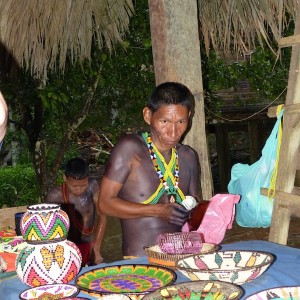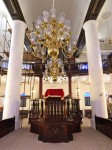Mikve Israel-Emanuel in Willemstad, Curaçao, is the oldest synagogue in continuous use in the Americas. (photo from Masada Siegel)
The night was aglow with candles and the silky white sand found its way in between my toes. I grinned, as it only added to the spirituality of the experience. Then, the chanting began.
No, I was not at an ashram or a yoga retreat. I was experiencing Shabbat services in the oldest synagogue in continuous use in the Americas, Mikve Israel-Emanuel in Willemstad, Curaçao.
Originally established in 1651 by settlers from Amsterdam, many in the community are of Spanish and Portuguese descent, as well. The settlers brought traditions from their ancestors, one of which was placing sand on the floor. During the Spanish Inquisition, secret Jews called conversos put sand on the floors of rooms in which they worshipped, which helped to muffle the sounds during services, and to avoid certain death if discovered. And so, today, sand is still placed on the floor of the synagogue to honor their ancestors and to remember the past.
My way of arrival to Curaçao was via a Holland America cruise, whose itineraries sometimes allow for late evening departures, allowing travelers to experience Shabbat services in a magnificent synagogue such as Mikve Israel-Emanuel.
Our ship, the Zuiderdam, was cozy and intimate, the food was plentiful and there was an explorer lounge filled with books, a coffee bar, fitness centre and the all-important spa. A cruise is one of the best ways to combine relaxation, excitement, scenic views and fabulous food. Kosher catering is also an option on this ship, we were told by the two Orthodox couples we befriended on deck. Holland America also offers shore excursions, as varied as city tours and swimming with dolphins.

Our adventure would take us from the majestic Mikve Israel to the thatched-roof homes of the Emberá tribe who live in the Panamanian rainforest. Experiencing the magnificent Panama Canal transit through the Gatun locks, steering through one of the 20th century’s greatest engineering marvels, we saw some tight squeezes, massive lock gates, boat-tugging locomotives and ongoing canal expansion work.
Finally, we disembarked, journeying via bus and then on motorized canoes back in time on the Chagres River in Chagres National Park, where we met members of a tribe that maintains traditions and a lifestyle from before the Spanish colonized Panama, more than 600 years ago.
Singing children and ornately decorated ladies with flowers in their hair greeted us upon our arrival to the jungle. The women were topless but were mostly covered in intricate non-permanent drawings and markings. They wore brightly colored sarongs as skirts. The men wore loincloths.
I wandered from the crowd and found myself photographing a young lady, and we started to communicate via pencil and paper, mostly laughing. As the rain started to pelt down from the sky, she invited me to stand under her house, which was on stilts, and to meet her two dogs. She was celebrating her birthday the next day and was excited. She motioned for me to come with her to meet some of her friends.

Eventually, I found my way to the centre of the village, which had a covered area where families were selling their creations. Each family had a table with their wares for sale.
The woven baskets were exquisite and a few found their way home with me, not to mention some sculptures, a wooden slingshot and brightly colored necklaces carved out of wood. Truth be told, the works were so stunning, I spent every penny I had with me.
The women prepared food and used large leaves folded as plates for serving. After dinner, members of the community performed some traditional dances for the visitors. The whole experience was a window into a world of yesteryear.
The rain came cascading down as we found our visit over and made our way back to the river and canoes. I soon found myself in the Sloth Sanctuary in Costa Rica.
Sloths are extremely slow-moving mammals found in the rainforest canopies of Central and South America. There are two species of sloths: two-toed and three-toed. Most sloths are about the size of a small dog.

Alaskan Judy Avey-Arroyo and her Costa Rican husband, Luis Arroyo, started the Sloth Sanctuary after three young neighbor girls brought them an orphaned three-fingered baby sloth.
They called the San José Zoo and a rescue centre for help, but soon realized they were on their own if they wished to save the sloth. They named her Buttercup and, 21 years later, she greets visitors at a sanctuary that has saved hundreds of the cute creatures and releases as many as possible back into the wild.
The Sloth Sanctuary is a family-run operation where the love of the furry creatures is obvious. It led me to reflect on all aspects of my journey, from the dedication of the people who created the synagogue hundreds of years ago to the world of yesteryear in the Panamanian jungle.
Every place and space we visited revealed a love and respect for heritage, nature and working together to build a better world. Perhaps this is why some of us are compelled to travel, to see the beauty, the goodness from other worlds and to take a piece of it home, to make our own worlds brighter, happier and more meaningful.
Masada Siegel can be reached at [email protected].

